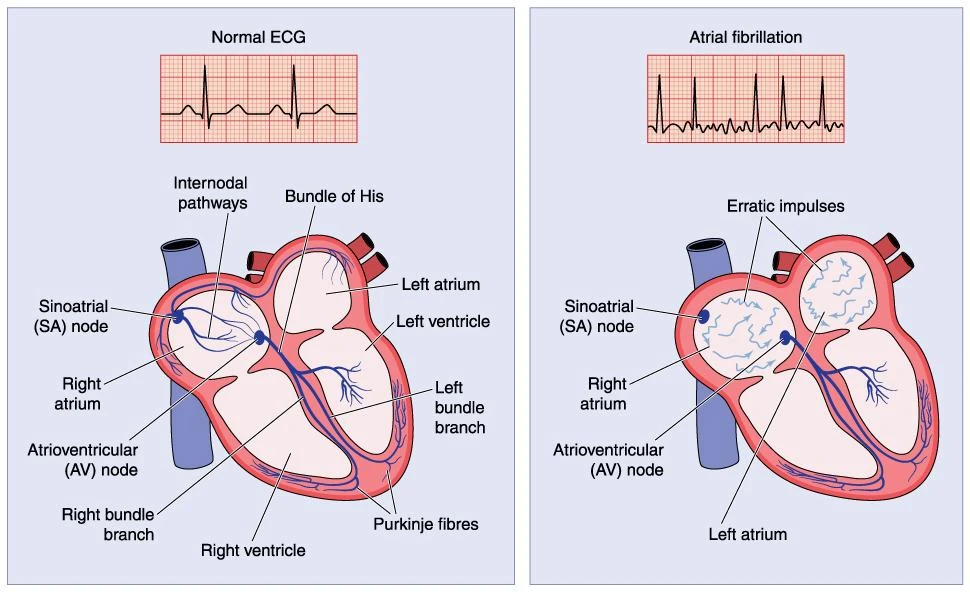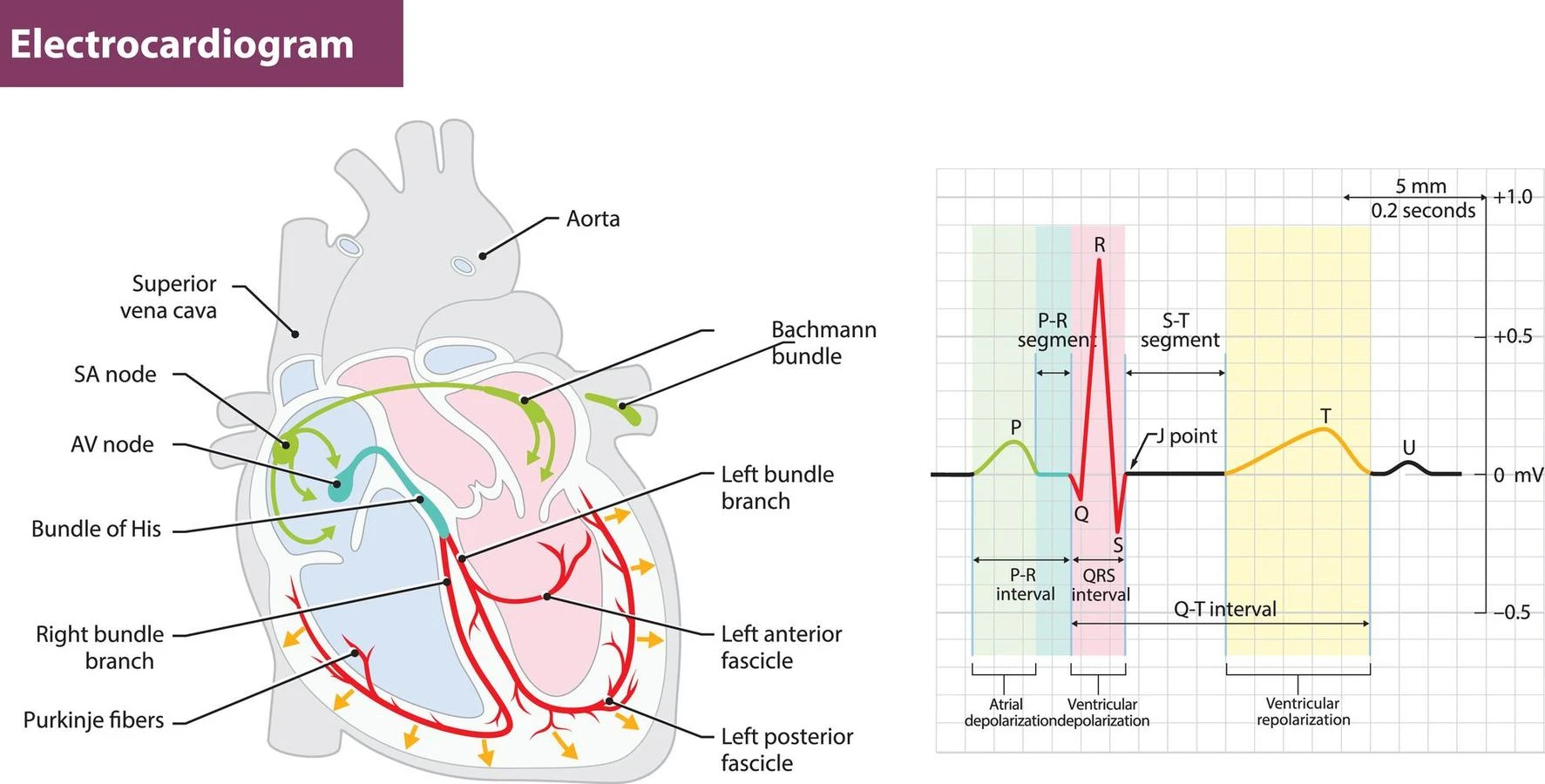Introduction
Atrial fibrillation (AFib) is a type of heart arrhythmia that affects the rhythm of the heartbeat. In AFib, the upper chambers of the heart beat irregularly, this leading to a fast and chaotic heartbeat. This lead to several symptoms, including palpitations, shortness of breath, lightheadedness, fatigue, and chest pain. AFib is a common condition, affecting millions of people around the world. Any age group can suffer from this but it is more common in older people.
Working of heart
The normal functioning of the heart involves the coordinated contraction and relaxation of its four chambers, the atria, and ventricles, to pump blood throughout the body.
- Blood flow: Blood flow refers to the movement of blood through the circulatory system. Circulatory system is composed of your heart, blood vessels, and blood. The heart pumps blood through the blood vessels, which carry the blood to every part of your body. Blood flow is vital because it delivers oxygen and nutrients to organs and tissues, allowing them to function properly.
- Electrical conduction system: The heart has a specialized electrical conduction system, consisting of specialized cells, that controls the heartbeat. The electrical impulses generates and transmits through this system that lead the heart to contract and pump blood.
- Blood pressure: Blood exert force against the walls of the blood vessels which is essential for proper blood circulation this is known as blood pressure. It is regulated by the heart and by the resistance of the blood vessels. Normal blood pressure is typically considered to be around 120/80 mmHg.
- Heart rate: The heart rate is the number of times the heart beats in a minute and is regulated by the electrical conduction system of the heart. A normal heart rate is typically between 60 and 100 beats per minute.

Types of Atrial Fibrillation
There are several different types of atrial fibrillation (AFib), including:
- Paroxysmal AFib: This type of AFib is characterized by episodes of irregular heartbeats that start and stop suddenly, often lasting less than seven days.
- Persistent AFib: In this type of AFib, irregular heartbeats last longer than seven days and may require medical intervention to restore a normal heart rhythm.
- Permanent AFib: This type of AFib refers to a state in which the heart remains in an irregular and rapid rhythm, with no possibility of restoring a normal rhythm without intervention.
- Lone AFib: This type of AFib occurs in individuals without any other underlying heart conditions or structural heart disease.
- Structural heart disease-related AFib: This type of AFib occurs in individuals with underlying heart conditions, like valve disease, heart failure, or hypertension.
Atrial Fibrillation causes
The exact cause of AFib is not always clear, but several factors can contribute to its development, including:
- Heart disease: Conditions like, high blood pressure, heart failure and heart valve disease can increase the risk of developing AFib.
- Structural heart problems: Abnormalities in the heart’s structure, such as enlarged atria or certain types of heart disease, can lead to AFib.
- Electrocution: Electrocution or injury to the heart from an electrical shock can cause AFib.
- Lung disease: Chronic lung diseases, such as emphysema and COPD, can increase the risk of developing AFib.
- Metabolic imbalances: Conditions such as thyroid disease, electrolyte imbalances, and liver disease can contribute to the development of AFib.
- Lifestyle factors: Factors such as excessive alcohol consumption, caffeine, and stimulant use can increase the risk of AFib.
- Family history: A family history of AFib can increase the risk of developing the condition.
Symptoms
Symptoms of atrial fibrillation include the following:
- Heart palpitations
- Angina
- Dizziness
- Fatigue
- Breathing issues
- Chest pain or angina
Diagnosis Atrial Fibrillation
The diagnosis of atrial fibrillation (AFib) typically involves a combination of a physical exam, medical history review, and various diagnostic tests. Some common diagnostic tests used to diagnose AFib include:
- Electrocardiogram (ECG): The electrical activity of the heart and can detect the presence of AFib in ECG records.
- Echocardiogram: An ultrasound of the heart that can help detect underlying heart conditions that may contribute to AFib is known as echocardiogram.
- Blood tests: Blood tests can help identify any underlying metabolic or hormonal imbalances that may contribute to AFib.

Treatments
The treatment of atrial fibrillation will depend on the severity of the condition and the underlying causes. Some common treatment options include:
- Medications, such as blood thinners, beta blockers, and calcium channel blockers
- Cardioversion, a procedure that uses electrical shock to restore a normal heartbeat
- Catheter ablation, a procedure that destroys small areas of heart tissue that are causing the irregular heartbeat
- Surgery, such as maze procedure or open-heart surgery
- Lifestyle changes, such as reducing alcohol and caffeine intake, quitting smoking, and maintaining a healthy weight
Lifestyle Changes to Manage Atrial Fibrillation
In addition to medical treatment, there are several lifestyle changes that can help manage atrial fibrillation, including:
- Eating a healthy diet
- Managing stress
- Exercising regularly
- Avoiding alcohol and caffeine
- Quitting smoking
Conclusion
The atria, or top chambers of the heart, beat quickly and irregularly in AFib, causing a rapid and erratic heartbeat. operating heart The heart’s four chambers, the atria and ventricles, coordinate their contraction and relaxation to circulate blood throughout the body. AFib risk can be impacted by illnesses such as heart failure, hypertension, and heart valve dysfunction. Echocardiography, which is a cardiac ultrasound, can assist identify underlying heart issues that may be responsible for AFib.
Frequently Asked Questions
1. Can atrial fibrillation be cured?
Atrial fibrillation cannot always be cured, but it can be managed with the appropriate treatment and lifestyle changes.
2. Is atrial fibrillation hereditary?
While atrial fibrillation can run in families, it is not always hereditary.
3. Can exercise make atrial fibrillation worse?
Exercise can trigger atrial fibrillation in some people, but regular exercise is still important for maintaining overall health. Consult with your doctor about the best exercise plan for you.
 Mission Statement
Mission Statement
“Empower every student to achieve full potential”
88Guru has been established with the social objective of making quality video-based learning material available to all Indian students. Technology, Connectivity and Social Media are rapidly changing the world of Education and we wish to lead the transformation of the tuition industry in India.
88Guru is the perfect complement to the current tuition model. 88Guru creates a wonderful opportunity for children and parents to bond while engaging in a valuable learning activity. It also provides the complete curriculum at your fingertips for those moments when you need some help at short notice. We believe that this mode of tuition could be transformational, adding hours to a child's day while providing complete control over the learning process.
Every course is taught by the best teachers from India's top schools and conducted in an engaging manner to keep students involved. The e-learning process consists of video-based instructions, computer-graded assignments, and a dashboard which allows the student and parent to track progress.


